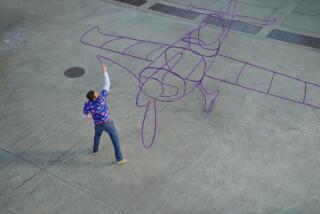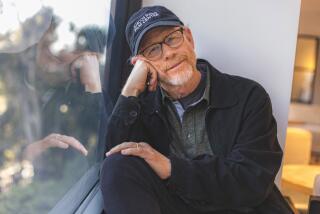MOVIE REVIEW : BIGFOOT ‘HARRY’ TRAVELS A FAMILIAR, GOOEY TRAIL
- Share via
“Harry and the Hendersons” (selected theaters) is a comic fantasy about a Seattle family taking home an injured bigfoot. In it, we watch the mesmerizing spectacle of a film maker immersing himself so thoroughly in the sensibility of another that he disappears--like a drowning man sinking slowly beneath waves of chocolate. The film maker is director, co-writer, co-producer William Dear, and the ocean in which he is drowning is Steven Spielberg--whose Amblin Entertainment produced “Harry,” and whose “E.T.” provided the definitive inspiration and form.
Dear’s debut feature looks and sounds like a Spielberg movie. It has a Spielberg theme: the beneficence and courage of white suburban America in a fairy-tale nightmare invasion. It has a Spielberg cameraman: Allen Daviau--who also shot “E.T.” and “Amblin.” And it has a Spielberg visual style: Disney filtered through Orson Welles, David Lean and Alfred Hitchcock.
It has Spielberg optimism and a high beautiful Spielberg sheen: Every technical credit is superb. In the movie, Spielberg people drive beneath Spielberg trees; Spielberg animals cock their furry little heads--or their furry big ones--and a Spielberg sun smiles down radiantly from a Spielberg sky upon a warm and lovable, if occasionally deranged, Spielberg town. The very houses seem to cry: “Spiel’s in his Berg; all’s right with the world!”
More than directors Tobe Hooper, Richard Donner or Barry Levinson, William Dear has gotten his boss’ look down pat. But he hasn’t captured Spielberg’s’ fairy-tale acumen, audience sense or flair for archetypes. This movie’s lovable bigfoot--as fashioned by Rick Baker and mimed by Kevin Peter Hall--is the movie’s major triumph. He’s a brutish, beguiling lumberer with expressive eyes and a bewitchingly mobile face. But is a lovable, victimized bigfoot really a good idea? Shouldn’t he be less of a persecuted klutz, more of an occasional Promethean hero?
Harry is a nudnik Noble Savage, pursued through town by a fearful populace, hog-wild and gun-crazy; chased through the backwoods by obsessive entrepreneurs. The idea, as in “E.T.,” is to contrast the intolerance of communities and the failures of rationalism and bigotry with the gut wisdom of kids and the generosity of families.
But there are only two primary, very thin, comic ploys. One: How do you hide a bigfoot crunching around your home while he decimates your refrigerator, furniture and floors? Two: Aren’t suburbanites silly? Dear and his writers belabor the first and belittle the second.
Their saga misses the mythic. It’s more sitcomish than legendary, and there are too many jokes where the Hendersons frantically try to disguise Harry’s presence, or where Harry clumps around, idiotically unobserved. The wondrous is often trivialized, and Seattle’s mass descent into lynch hysteria has the zapped-up inevitability of a video game.
Along with the production values--and “Harry” himself--John Lithgow, as George Henderson, is the glue that holds everything together. Lithgow is an unusually sensitive actor with a genuine gift for frenzy: Sometimes, his constricted voice and pale, bulging eyes seem ablaze with repressed hysteria. His Henderson has a shambling, tamed bravado. He’s conceived as a warm, decent man driven by a macho father (M. Emmet Walsh as the local gun peddler), and Lithgow makes sense of this stereotyped role: the huntsman who wants to draw, the artist manque in a Seattle Seahawk T-shirt. He juggles both sides against each other, and his reactions to Harry--wild-eyed, wary, dazed or exhilarated--are wonderful.
But Lithgow and Hall provide the movie’s only major interaction. Melinda Dillon has a dithery role, with ditzy gags--fussily wiping off the refrigerator after it’s been toppled and totaled--and the children (Margaret Langrick and Joshua Rudoy) tend toward the wide-eyed, cute and bland. Even the villains--David Suchet and Don Ameche as his crusty employer--are spiceless monomaniacs.
The technical triumphs of “Harry and the Hendersons” (MPAA rated: PG) often seem to overpower its weak, juiceless Froot Loops gags. There’s often too much gloss and treacle for adults, if not for their child escorts.
Within Harry’s hairy hide beats a heart pure, honest--and a bit gooey. That’s somewhat the movie’s condition, too. It’s overwhelming and, in a curious way, it’s charming, but at the center, even though you see it in the right place, you detect not a heart, or a mind, but something like a hot, roasted marshmallow beating and burbling within a thickened, ursine breast.
‘HARRY AND THE HENDERSONS’ A Universal/Amblin Entertainment production. Producers Richard Vane, William Dear. Director Dear. Script Dear, William E. Martin, Ezra Rappaport. Camera Allen Daviau. Production design James Bissell. Editor Donn Cambern. Music Bruce Broughton. With John Lithgow, Melinda Dillon, Margaret Langrick, Joshua Ruddy, Don Ameche, David Suchet, Lainie Kazan.
Running time: 1 hour, 50 minutes.
MPAA rating: PG (parental guidance suggested; some material may not be suitable for children).
More to Read
Only good movies
Get the Indie Focus newsletter, Mark Olsen's weekly guide to the world of cinema.
You may occasionally receive promotional content from the Los Angeles Times.









